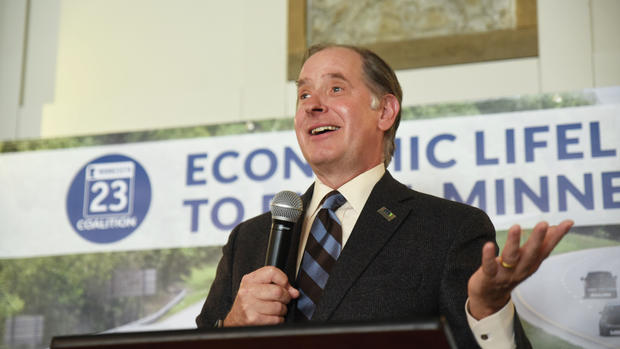SPICER—On a bus ride from Paynesville to Spicer, Minnesota Transportation Commissioner Charles Zelle saw trucks hauling wind turbine blades south on Highway 23.
Zelle jokingly asked members of the Highway 23 Coalition Friday if they had arranged for those trucks so he could see the need for a four-lane state Highway 23 from Willmar to Interstate 94. The coalition hosted Zelle at a luncheon in Spicer and took him on tours of pending road projects, including the Willmar Wye.
Currently, the road has two two-lane bottlenecks along that route—seven miles of two-lane road south of Paynesville and eight miles north of Paynesville. There is no timetable for making the entire stretch of road four lanes.
Zelle told the packed house at O’Neil’s in Spicer he could see the Highway 23 project is needed, even without seeing the huge turbine blades moving through a bottleneck.
“It’s a great project,” he said, “but there’s a lot of projects like that around the state.”
Like members of the Highway 23 Coalition, government and business leaders in all corners of the state talk to him about their projects, Zelle said, and they seem to say to him, “How could the money go anywhere else?”
Zelle said he was impressed with the patience and organization of the Highway 23 advocates. The coalition was formed earlier this year to lay the groundwork for the project when funding becomes available. The coalition has 47 members, 14 units of government, 26 businesses, four organizations and three individuals.
The problem for the Minnesota Department of Transportation is finding the money. There isn’t enough funding to maintain the state’s 140,000 miles of road and try to make improvements to the system, too, he said.
Minnesota has more miles of road than all but five states, he said. “I think that’s partly why we have such a robust economy.”
MnDOT needs to work with local governments and businesses to provide a transportation system that meets the state’s needs, he said. That includes economic, health and safety needs, he added.
The 2017 Legislature appropriated about $200 million for the state’s roads, he said, and the department also has the ability to borrow about $850 million to remain under its debt limit.
Zelle said it’s important to be strategic in how the money is spent and try to develop a statewide vision for transportation.
“In Minnesota we all come together and figure it out when it’s important,” he said.
During a question session, Zelle was asked if there was a “magic number” that would be enough funding for the state’s roads. Adequate funding might be $6 billion over 10 years and $15 billion over 20 years, he said. That figure does not include county or city needs.
He agreed that it was a large number but added “the price goes up the longer we let it go.”
Others in the room reminded him that Highway 23 is the only link from Sioux Falls to Duluth.
West Central Tribune by Linda Vanderwerf

